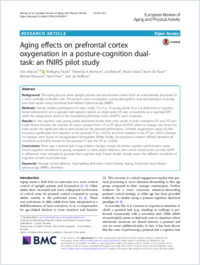Aging effects on prefrontal cortex oxygenation in a posture-cognition dual-task: an fNIRS pilot study
- Marusic, Uros Institute for Kinesiology Research, Science and Research Centre Koper, Slovenia - Department of Health Sciences, Alma Mater Europaea – ECM, Maribor, Slovenia
- Taube, Wolfgang Department of Neurosciences and Movement Sciences, University of Fribourg, Switzerland
- Morrison, Shawnda A. Department of kinesiology and physiotherapy, Faculty of Health Sciences, University of Primorska, Izola, Slovenia
- Biasutti, Lea Department of Medical and Biological Sciences, Udine University, Udine, Italy
- Grassi, Bruno Department of Medical and Biological Sciences, Udine University, Udine, Italy
- Pauw, Kevin De Research Group Human Physiology, Vrije Universiteit Brussel, Brussels, Belgium
- Meeusen, Romain Research Group Human Physiology, Vrije Universiteit Brussel, Brussels, Belgium
- Pisot, Rado Institute for Kinesiology Research, Science and Research Centre Koper, Slovenia - Faculty of sport, University of Ljubljana, Slovenia
- Ruffieux, Jan Department of Neurosciences and Movement Sciences, University of Fribourg, Switzerland
-
11.01.2019
Published in:
- European Review of Aging and Physical Activity. - 2019, vol. 16, no. 1, p. 2
English
The aging process alters upright posture and locomotion control from an automatically processed to a more cortically controlled one. The present study investigated a postural-cognitive dual-task paradigm in young and older adults using functional Near- Infrared Spectroscopy (fNIRS).Methods: Twenty healthy participants (10 older adults 72 ± 3 y, 10 young adults 23 ± 3 y) performed a cognitive (serial subtractions) and a postural task (tandem stance) as single-tasks (ST) and concurrently as a dual-task (DT) while the oxygenation levels of the dorsolateral prefrontal cortex (DLPFC) were measured.Results: In the cognitive task, young adults performed better than older adults in both conditions (ST and DT) and could further increase the number of correct answers from ST to DT (all ps ≤ 0.027) while no change was found for older adults. No significant effects were found for the postural performance. Cerebral oxygenation values (O2Hb) increased significantly from baseline to the postural ST (p = 0.033), and from baseline to the DT (p = 0.031) whereas no changes were found in deoxygenated hemoglobin (HHb). Finally, the perceived exertion differed between all conditions (p ≤ 0.003) except for the postural ST and the DT (p = 0.204).Conclusions: There was a general lack of age-related changes except the better cognitive performance under motor-cognitive conditions in young compared to older adults. However, the current results point out that DLPFC is influenced more strongly by postural than cognitive load. Future studies should assess the different modalities of cognitive as well as postural load.
- Faculty
- Faculté des sciences et de médecine
- Department
- Département de Médecine
- Language
-
- English
- Classification
- Biological sciences
- License
- License undefined
- Identifiers
-
- RERO DOC 324126
- DOI 10.1186/s11556-018-0209-7
- Persistent URL
- https://folia.unifr.ch/unifr/documents/307678
Statistics
Document views: 62
File downloads:
- tau_aep.pdf: 138
